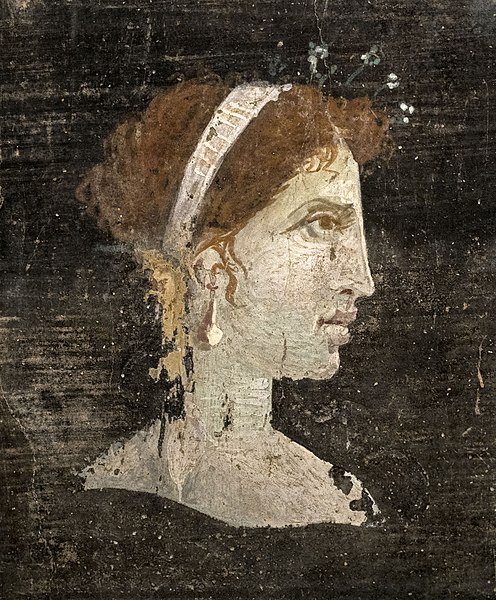| 설명Retrato femenino (26771127162).jpg |
Español: Es un pintura al fresco procedente de una casa en Herculano de mediados del siglo I destruida por la erupción del Vesubio en el año 79. Pertenece al Museo Archeologico Nazionale, Nápoles, y se expuso en Arte Canal, Madrid, en "Cleopatra y la fascinación de Egipto".
English: A posthumous painted portrait of Cleopatra VII of Ptolemaic Egypt from Roman Herculaneum, made during the 1st century AD, i.e. before the destruction of Herculaneum by the volcanic eruption of Mount Vesuvius; it is located in the National Archaeological Museum of Naples. Dr. Joann Fletcher ( Cleopatra the Great: the Woman Behind the Legend, New York: Harper, 2008, plates between pp. 246-247), Honorary Research Fellow at the University of York, writes the following in description of this painting:
Painted image from a villa at Herculaneum portraying a red-haired woman whose facial features, royal diadem and hairstyle adorned with fine pearl-studded hairpins suggest a posthumous portrait of Cleopatra VII.
Fletcher describes the painting further on page 87:
Cleopatra's hair was maintained by her highly skilled hairdresser Eiras. Although rather artificial looking wigs set in the traditional tripartite style of long straight hair would have been required for her appearances before her Egyptian subjects, a more practical option for general day-to-day wear was the no-nonsense 'melon hairdo' in which her natural hair was drawn back in sections resembling the lines on a melon and then pinned up in a bun at the back of the head. A trademark style of Arsinoe II and Berenike II, the style had fallen from fashion for almost two centuries until revived by Cleopatra; yet as both traditionalist and innovator, she wore her version without her predecessor's fine head veil. And whereas they had both been blonde like Alexander, Cleopatra may well have been a redhead, judging from the portrait of a flame-haired woman wearing the royal diadem surrounded by Egyptian motifs which has been identified as Cleopatra.
The painting is also described in Susan Walker and Peter Higgs (2001), Cleopatra of Egypt: From History to Myth, Princeton, N.J.: Princeton University Press, ISBN 9780691088358. Walker and Higgs (2001: pp. 314-315) date the painting from Herculaneum as belonging to the 1st century AD, contiguous with the Pompeian Third Style, and describe it as thus:
The large frame with black painted background contains a small bust of a woman in profile. Her face and neck are painted white and her hair reddish brown, and the rather stark effect is not unlike a cameo, as Reinhard Herbig proposed. She wears a diadem, painted white with a geometric design, and an earring with a ball-shaped pendant. The woman's hair is parted at the centre and then swept back and secured in a bun: a few locks hang loosely in front of her ear. Over the brow a large tuft of hair is painted, rather like the nodus found on portraits of women of the later 1st century BC, and perhaps originally on the marble portraits of Cleopatra from Berlin...and the Vatican...The large eye (a late Ptolemaic feature), long nose, and full lips are also comparable to the features of Cleopatra as seen on her marble portraits and some of her coins. The effect is somewhat more idealized than, for instance, the Antioch coin portraits, but there are similarities. The diadem suggests that this woman is royal. A close comparison to this painted portrait is to be found on the walls of the House of the Orchard at Pompeii. This house contained several Egyptianizing scenes, and the comparable bust is painted in a frame, not unlike this one, next to a Greek-style sphinx. The woman in the Pompeian painting has a blue cross-band around her head, not quite a royal diadem, but the form of the bust is identical.
|


